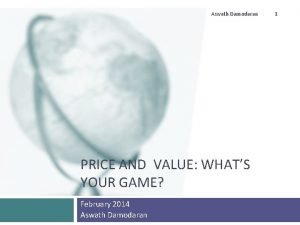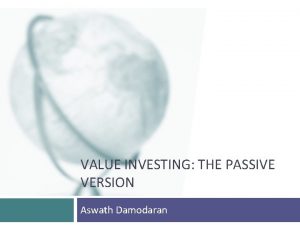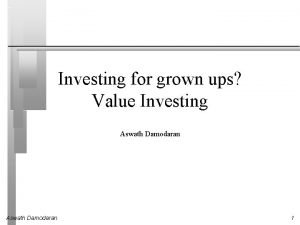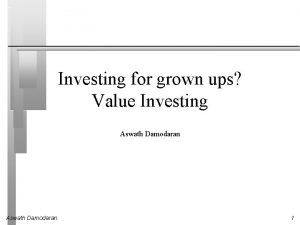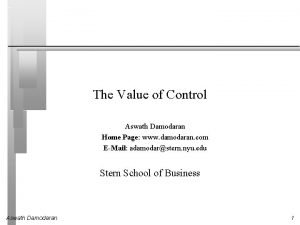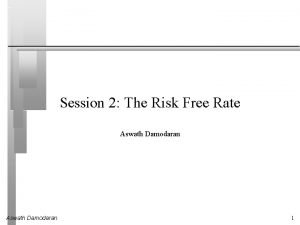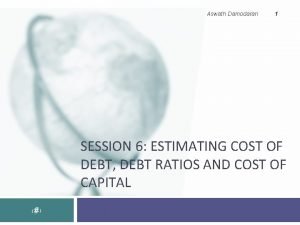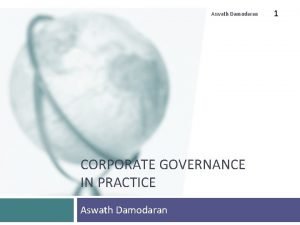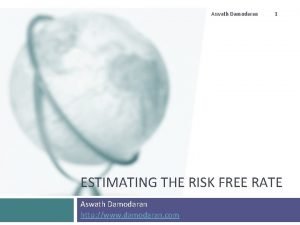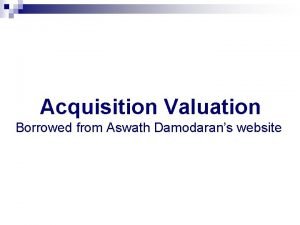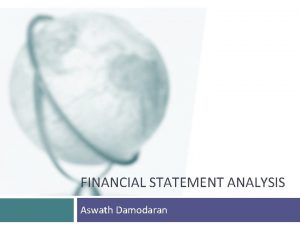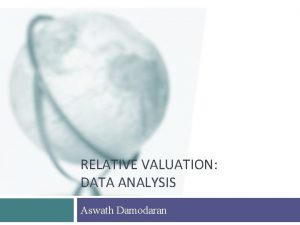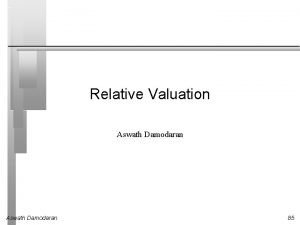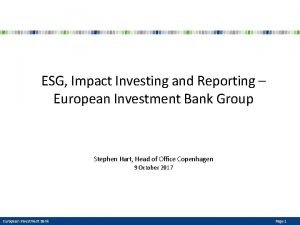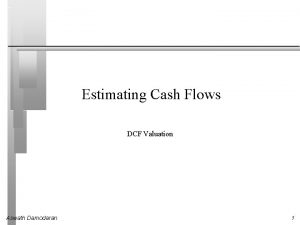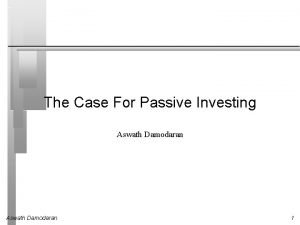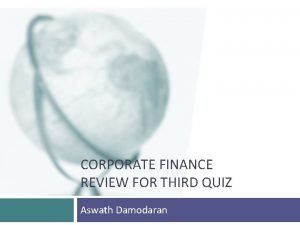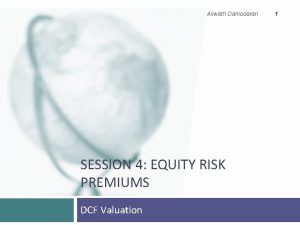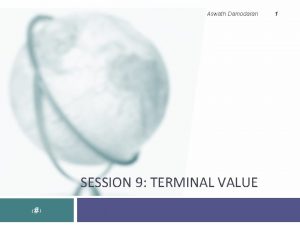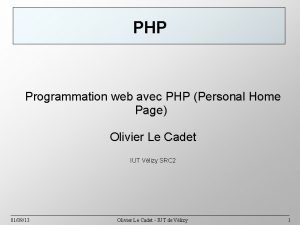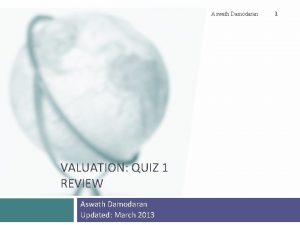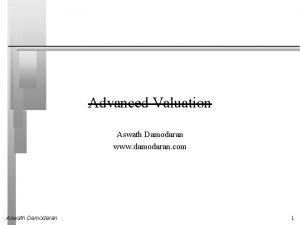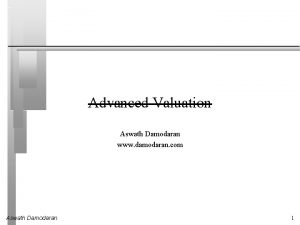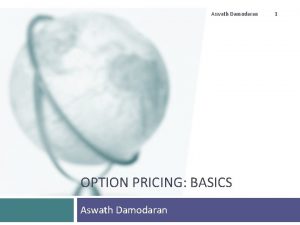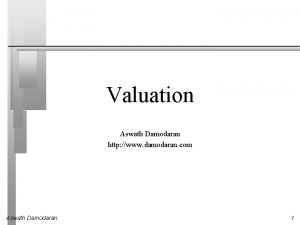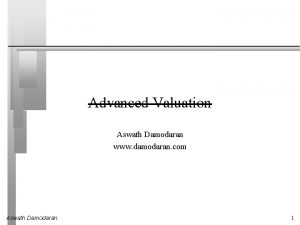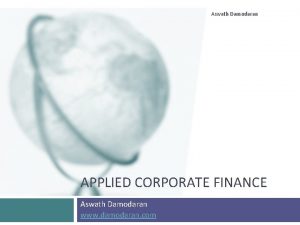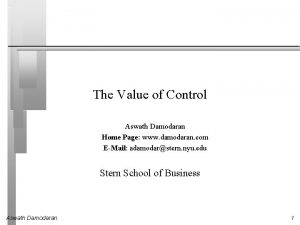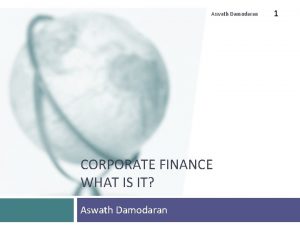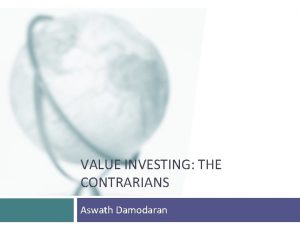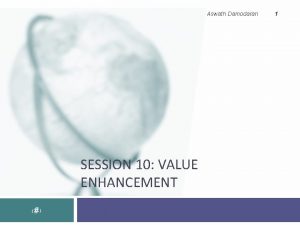The Value of Control Aswath Damodaran Home Page






































- Slides: 38

The Value of Control Aswath Damodaran Home Page: www. damodaran. com E-Mail: adamodar@stern. nyu. edu Stern School of Business Aswath Damodaran 1

Why control matters… When valuing a firm, the value of control is often a key factor is determining value. For instance, • In acquisitions, acquirers often pay a premium for control that can be substantial • When buying shares in a publicly traded company, investors often pay a premium for voting shares because it gives them a stake in control. • In private companies, there is often a discount atteched to buying minority stakes in companies because of the absence of control. Aswath Damodaran 2

What is the value of control? The value of controlling a firm derives from the fact that you believe that you or someone else would operate the firm differently (and better) from the way it is operated currently. The expected value of control is the product of two variables: • • Aswath Damodaran the change in value from changing the way a firm is operated the probability that this change will occur 3

Discounted Cashflow Valuation: Basis for Approach where CFt is the expected cash flow in period t, r is the discount rate appropriate given the riskiness of the cash flow and n is the life of the asset. Proposition 1: For an asset to have value, the expected cash flows have to be positive some time over the life of the asset. Proposition 2: Assets that generate cash flows early in their life will be worth more than assets that generate cash flows later; the latter may however have greater growth and higher cash flows to compensate. Aswath Damodaran 4

Equity Valuation Aswath Damodaran 5

Firm Valuation Aswath Damodaran 6

Valuation with Infinite Life Aswath Damodaran 7

Aswath Damodaran 8

Aswath Damodaran 9

A. Value of Gaining Control Using the DCF framework, there are four basic ways in which the value of a firm can be enhanced: • The cash flows from existing assets to the firm can be increased, by either – increasing after-tax earnings from assets in place or – reducing reinvestment needs (net capital expenditures or working capital) • The expected growth rate in these cash flows can be increased by either – Increasing the rate of reinvestment in the firm – Improving the return on capital on those reinvestments • • The length of the high growth period can be extended to allow for more years of high growth. The cost of capital can be reduced by – Reducing the operating risk in investments/assets – Changing the financial mix – Changing the financing composition Aswath Damodaran 10

I. Ways of Increasing Cash Flows from Assets in Place Aswath Damodaran 11

II. Value Enhancement through Growth Aswath Damodaran 12

III. Building Competitive Advantages: Increase length of the growth period Aswath Damodaran 13

IV. Reducing Cost of Capital Aswath Damodaran 14

SAP : Optimal Capital Structure Aswath Damodaran 15

Aswath Damodaran 16

Aswath Damodaran 17

Aswath Damodaran 18

B. The Probability of Changing Control The probability of changing management will be different across different companies and will vary across different markets. In general, the more power stockholders have and the stronger corporate governance systems are, the greater is the probability of management change for any given firm. The probability of changing management will change over time as a function of legal changes, market developments and investor shifts. Aswath Damodaran 19

Mechanisms for changing management Activist investors: Some investors have been willing to challenge management practices at companies by offering proposals for change at annual meetings. While they have been for the most part unsuccessful at getting these proposals adopted, they have shaken up incumbent managers. Proxy contests: In proxy contests, investors who are unhappy with management try to get their nominees elected to the board of directors. Forced CEO turnover: The board of directors, in exceptional cases, can force out the CEO of a company and change top management. Hostile acquisitions: If internal processes for management change fail, stockholders have to hope that another firm or outside investor will try to take over the firm (and change its management). Aswath Damodaran 20

Determinants of Likelihood of Change: Institutional Factors Capital restrictions: In markets where it is difficult to raise funding for hostile acquisitions, management change will be less likely. Hostile acquisitions in Europe became more common after the corporate bond market developed. State Restrictions: Some markets restrict hostile acquisitions for parochial (France and Dannon, US and Unocal), political (Pennsylvania’s anti-takeover law to protect Armstrong Industries), social (loss of jobs) and economic reasons (prevent monopoly power). Inertia and Conflicts of Interest: If financial service institutions (banks and investment banks) have ties to incumbent managers, it will become difficult to change management. Aswath Damodaran 21

Determinants of the Likelihood of Change: Firm-specific factors Anti-takeover amendments: Corporate charters can be amended, making it more difficult for a hostile acquirer to acquire the company or dissident stockholders to change management. Voting Rights: Incumbent managers get voting rights which are disproportional to their stockholdings, by issuing shares with no voting rights or reduced voting rights to the public. Corporate Holding Structures: Cross holdings and Pyramid structures are designed to allow insiders with small holdings to control large numbers of firms. Large Stockholders as managers: A large stockholder (usually the founder) is also the incumbent manager of the firm. Aswath Damodaran 22

Why the probability of management changing shifts over time…. Corporate governance rules can change over time, as new laws are passed. If the change gives stockholders more power, the likelihood of management changing will increase. Activist investing ebbs and flows with market movements (activist investors are more visible in down markets) and often in response to scandals. Events such as hostile acquisitions can make investors reassess the likelihood of change by reminding them of the power that they do possess. Aswath Damodaran 23

Estimating the Probability of Change You can estimate the probability of management changes by using historical data (on companies where change has occurred) and statistical techniques such as probits or logits. Empirically, the following seem to be related to the probability of management change: • • Aswath Damodaran Stock price and earnings performance, with forced turnover more likely in firms that have performed poorly relative to their peer group and to expectations. Structure of the board, with forced CEO changes more likely to occur when the board is small, is composed of outsiders and when the CEO is not also the chairman of the board of directors. Ownership structure; forced CEO changes are more common in companies with high institutional and low insider holdings. They also seem to occur more frequently in firms that are more dependent upon equity markets for new capital. Industry structure, with CEOs more likely to be replaced in competitive industries. 24

Manifestations of the Value of Control Hostile acquisitions: In hostile acquisitions which are motivated by control, the control premium should reflect the change in value that will come from changing management. Valuing publicly traded firms: The market price for every publicly traded firm should incorporate an expected value of control, as a function of the value of control and the probability of control changing. Market value = Status quo value + (Optimal value – Status quo value)* Probability of management changing Voting and non-voting shares: The premium (if any) that you would pay for a voting share should increase with the expected value of control. Minority Discounts in private companies: The minority discount (attached to buying less than a controlling stake) in a private business should be increase with the expected value of control. Aswath Damodaran 25

1. Hostile Acquisition: Example In a hostile acquisition, you can ensure management change after you take over the firm. Consequently, you would be willing to pay up to the optimal value. As an example, Blockbuster was trading at $9. 50 per share in July 2005. The optimal value per share that we estimated as $ 12. 47 per share. Assuming that this is a reasonable estimate, you would be willing to pay up to $2. 97 as a premium in acquiring the shares. Issues to ponder: • • Aswath Damodaran Would you automatically pay $2. 97 as a premium per share? Why or why not? What would your premium per share be if change will take three years to implement? 26

Hostile Acquisitions: Implications a. The value of control will vary across firms: Since the control premium is the difference between the status-quo value of a firm and its optimal value, it follows that the premium should be larger for poorly managed firms and smaller for well managed firms. b. There can be no rule of thumb on control premium: Since control premium will vary across firms, there can be no simple rule of thumb that applies across all firms. The notion that control is always 20 -30% of value cannot be right. c. The control premium should vary depending upon why a firm is performing badly: The control premium should be higher when a firm is performing badly because of poor management decisions than when a firm’s problems are caused by external factors over which management has limited or no control. d. The control premium should be a function of the ease of making management changes: Not all changes are easy to make or quick to implement. It is far easier to change the financing mix of an under levered company than it is to modernize the plant and equipment of a manufacturing company with old and outdated plants. Aswath Damodaran 27

Hostile Acquisitions: Evidence of a control effect a. Premiums paid for target firms in acquisitions: While the average premium paid for target firms in acquisitions in the United States has been between 20 and 30% in the 1980 s and 1990 s, the premiums tend to be slightly higher for hostile acquisitions. In addition, bidding firm returns which tend to be negligible or slightly negative across all acquisitions are much more positive on hostile acquisitions. b. Target firm characteristics: Target firms in hostile takeovers have earned a 2. 2% lower return on equity, on average, than other firms in their industry; they have earned returns for their stockholders that are 4% lower than the market; and only 6. 5% of their stock is held by insiders. The typical target firm is characterized by poor project choice and stock price performance as well as low insider holdings. c. Post-acquisition actions: contrary to popular view, most hostile takeovers are not followed by the acquirer stripping the assets of the target firm and leading it to ruin. Instead, target firms refocus on their core businesses and often improve their operating performance. Aswath Damodaran 28

2. Market prices of Publicly Traded Companies: An example The market price per share at the time of the valuation (May 2005) was roughly $9. 50. Expected value per share = Status Quo Value + Probability of control changing * (Optimal Value – Status Quo Value) $ 9. 50 = $ 5. 13 + Probability of control changing ($12. 47 - $5. 13) The market is attaching a probability of 59. 5% that management policies can be changed. This was after Icahn’s successful challenge of management. Prior to his arriving, the market price per share was $8. 20, yielding a probability of only 41. 8% of management changing. Aswath Damodaran 29

Market Prices for Publicly Traded Firms: Implications a. Paying a premium over the market price can result in over payment: In a firm where the market already assumes that management will be changed and builds it into the stock price, acquirers should be wary of paying a premium on the current market price even for a badly managed firm. b. Anything that causes market perception of the likelihood of management change to shift can have large effects on all stocks. A hostile acquisition of one company, for instance, may lead investors to change their assessments of the likelihood of management change for all companies and to an increase in stock prices. c. Poor corporate governance = Lower stock prices: Stock prices in a market where corporate governance is effective will reflect a high likelihood of change for bad management and a higher expected value for control. In contrast, it is difficult, if not impossible, to dislodge managers in markets where corporate governance is weak. Stock prices in these markets will therefore incorporate lower expected values for control. The differences in corporate governance are likely to manifest themselves most in the worst managed firms in the market. Aswath Damodaran 30

Market Price for Publicly Traded Firms: Evidence of a control effect a. Hostile Acquisitions: If the prices of all stocks reflect the expected value of control, any actions that make hostile acquisitions more or less likely will affect stock prices. When Pennsylvania passed its anti-takeover law in 1989, Pennsylvania firms saw their stock prices decline 6. 90%. b. Management Changes: In badly managed firms, a forced CEO turnover with an outside successor has the most positive consequences, especially when the outsider is viewed as someone capable of changing the way the firm is run. c. Corporate Governance: – Gompers, Ishi and Metrick found that the stocks with the weakest stockholder power earned 8. 4% less in annual returns than stockholders with the strongest stockholder power. They also found that an increase of 1% in the poor governance index translated into a decline of 2. 4% in the firm’s Tobin’s Q, which is the ratio of market value to replacement cost. – Bris and Cabolis look at target firms in 9277 cross-border mergers, where the corporate governance system of the target is in effect replaced by the corporate governance system of the acquirer. They find that the Tobin’s Q increases for firms in an industry when a firm or firms in that industry are acquired by foreign firms from countries with better corporate governance Aswath Damodaran 31

3. Voting and Non-voting Shares: An Example To value voting and non-voting shares, we will consider Embraer, the Brazilian aerospace company. As is typical of most Brazilian companies, the company has common (voting) shares and preferred (non-voting shares). • • There are 242. 5 million voting shares and 476. 7 non-voting shares in the company and the probability of management change is relatively low. Assuming a probability of 20% that management will change, we estimated the value per non-voting and voting share: • • Status Quo Value = 12. 5 billion $R for the equity; Optimal Value = 14. 7 billion $R, assuming that the firm would be more aggressive both in its use of debt and in its reinvestment policy. Value per non-voting share = Status Quo Value/ (# voting shares + # non-voting shares) = 12, 500/(242. 5+476. 7) = 17. 38 $R/ share Value per voting share = Status Quo value/sh + Probability of management change * (Optimal value – Status Quo Value) = 17. 38 + 0. 2* (14, 700 -12, 500)/242. 5 = 19. 19 $R/share With our assumptions, the voting shares should trade at a premium of 10. 4% over the non-voting shares. Aswath Damodaran 32

Voting and Non-voting Shares: Implications a. The difference between voting and non-voting shares should go to zero if there is no chance of changing management/control. If there are relatively few voting shares, held entirely by insiders, the probability of management change may very well be close to zero and voting shares should trade at the same price as non-voting shares. b. Other things remaining equal, voting shares should trade at a larger premium on nonvoting shares at badly managed firms than well-managed firms. In a badly managed firm, the expected value of control is likely to be higher. c. Other things remaining equal, the smaller the number of voting shares relative to nonvoting shares, the higher the premium on voting shares should be. The expected value of control is divided by the number of voting shares to get the premium; the smaller that number, the greater the value per share. d. Other things remaining equal, the greater the percentage of voting shares that are available for trading by the general public (float), the higher the premium on voting shares should be. When voting shares are predominantly held by insiders, the probability of control changing is small and so is the expected value of control. e. Any event that illustrates the power of voting shares relative to non-voting shares is likely to affect the premium at which all voting shares trade. Aswath Damodaran 33

Voting and Non-voting Shares: Evidence of a control effect a. Differences in voting share premiums: In the United States. Lease, Mc. Connell and Mikkelson (1983) found that voting shares in that market trade, on average, at a relatively small premium of 5 -10% over non-voting shares. Premiums of a magnitude similar to those found in the United States (5 -10%) were found in the United Kingdom and Canada. Much larger premiums are reported in Latin America (50 -100%), Israel (75%) and Italy (80%). b. Changes in law: In an attempt to isolate the effect of control on voting share premiums, Linciano examined the effects of changes in takeover law and corporate governance on Italian voting and non-voting shares. A “mandatory bid” rule, introduced in 1992 in Italy, allowed small voting shareholders to receive the same price in an acquisition as large voting shareholders but did not extend to non-voting shareholders. Not surprisingly, the premium on voting shares increased marginally (about 2%) after this rule. Aswath Damodaran 34

4. Minority Discount: An example Assume that you are valuing Kristin Kandy, a privately owned candy business for sale in a private transaction. You have estimated a value of $ 1. 6 million for the equity in this firm, assuming that the existing management of the firm continues into the future and a value of $ 2 million for the equity with new and more creative management in place. • • Value of 51% of the firm = 51% of optimal value = 0. 51* $ 2 million = $1. 02 million Value of 49% of the firm = 49% of status quo value = 0. 49 * $1. 6 million = $784, 000 Note that a 2% difference in ownership translates into a large difference in value because one stake ensures control and the other does not. Aswath Damodaran 35

Minority Discount: Implications a. The minority discount should vary inversely with management quality: If the minority discount reflects the value of control (or lack thereof), it should be larger for firms that are poorly run and smaller for well-run firms. b. Control may not always require 51%: While it is true that you need 51% of the equity to exercise control of a private firm when you have only two co-owners, it is possible to effectively control a firm with s smaller proportion of the outstanding stock when equity is dispersed more investors. c. The value of an equity stake will depend upon whether it provides the owner with a say in the way a firm is run: Many venture capitalists play an active role in the management of the firms that they invest in and the value of their equity stake should reflect this power. In effect, the expected value of control is built into the equity value. In contrast, a passive private equity investor who buys and holds stakes in private firms, without any input into the management process, should value her equity stakes at a lower value. Aswath Damodaran 36

Minority Discount: Evidence of a control effect a. Private company valuations: There is clear evidence that practitioners apply control premiums in private company transactions, ranging from 15 to 20% for a majority stake; conversely, this translates into an equivalent discount for a minority stake. b. Large transactions in publicly traded companies: Hanouna, Sarin and Shapiro (2001) attempt to estimate the extent of the minority discount by classifying 9566 transactions in publicly traded companies into minority and majority transactions based upon ownership before and after the transaction; They find that minority transactions are valued at a discount of 20 -30% on majority transactions in “market oriented” economies like the UK and the US but that the discount is smaller in “bank oriented” economies like Germany, Japan, France and Italy. c. Block Buys: Barclay and Holderness (1989, 1991) report premiums in excess of 10% for large negotiated block transactions in the United States. Nicodano and Sembenelli (2000) extend the analysis to look at block transactions in Italy and conclude that the average premium across large block trades is 27%; the premium increases with block size with premiums of 31% for blocks larger than 10% and 24% for blocks smaller than 10%. Aswath Damodaran 37

To conclude… The value of control in a firm should lie in being able to run that firm differently and better. Consequently, the value of control should be greater in poorly performing firms, where the primary reason for the poor performance is the management. The market value of every firm reflects the expected value of control, which is the product of the probability of management changing and the effect on value of that change. This has far ranging implications. In acquisitions, the premiums paid should reflect how much the price already reflects the expected value of control; in a market that already reflects a high value for expected control, the premiums should be smaller. With companies with voting and non-voting shares, the premium on voting shares should reflect the expected value of control. If the probability of control changing is small and/or the value of changing management is small (because the company is well run), the expected value of control should be small and so should the voting stock premium. In private company valuation, the discount applied to minority blocks should be a reflection of the value of control. Aswath Damodaran 38
 Value investing damodaran
Value investing damodaran Aswath damodaran intrinsic value
Aswath damodaran intrinsic value Aswath damodaran intrinsic value
Aswath damodaran intrinsic value Aswath damodaran value investing
Aswath damodaran value investing Damodaran
Damodaran Damodaran
Damodaran Damodaran control premium
Damodaran control premium Risk free rate damodaran
Risk free rate damodaran Types of investment philosophies
Types of investment philosophies Aswath damodaran portfolio
Aswath damodaran portfolio Damodaran statistics
Damodaran statistics Cost of debt damodaran
Cost of debt damodaran Multiples damodaran
Multiples damodaran Aswath damodaran net worth
Aswath damodaran net worth Aswath damodaran discount rate
Aswath damodaran discount rate Damodaran ebitda multiples
Damodaran ebitda multiples Aswath damodaran age
Aswath damodaran age Risk free rate damodaran
Risk free rate damodaran Damodarans
Damodarans Contrarian value investing
Contrarian value investing Which items are miscategorized balance sheet
Which items are miscategorized balance sheet Aswath damodaran
Aswath damodaran Aswath damodaran discount rate
Aswath damodaran discount rate Damodaran portfolio
Damodaran portfolio Damodaran data
Damodaran data Aswath damodaran multiples
Aswath damodaran multiples Damodaran on valuation review
Damodaran on valuation review Damodaran
Damodaran Aswath damodaran esg
Aswath damodaran esg Fcfe damodaran
Fcfe damodaran Damodaran
Damodaran Aswath damodaran review
Aswath damodaran review Aswath damodaran erp
Aswath damodaran erp Startup valuation damodaran
Startup valuation damodaran Value creation value delivery value capture
Value creation value delivery value capture Terminal value damodaran
Terminal value damodaran Valuation of private companies
Valuation of private companies What should be on a title page
What should be on a title page Home.php
Home.php


